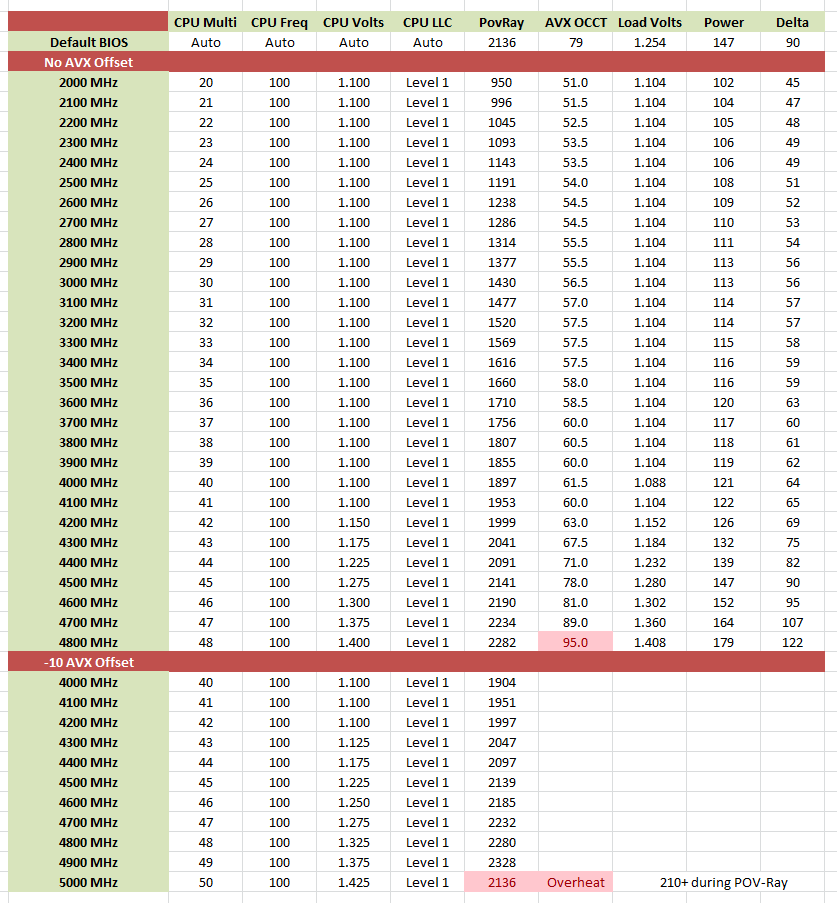 04.01.2017., 00:12
04.01.2017., 00:12
|
#375
|
|
Premium
Datum registracije: Jul 2012
Lokacija: vk+
Postovi: 14,584
|
Čuj i toma (koji je testirao 2 puta klik, klik) je mislio da je možda do Z170 mbo, pa ako to spojimo sa ovim od gamernexusa sa Z270... Na istim ili većim voltažama i7 6700K ima primjetno manje temperature...
E sad što se tiče mbo, očito neke pumpaju previsok napon pa bi useri trebali to manualno podešavati ili čekati bios update. Ali ono što želim istaknuti je nazadovane u temp naspram skylake
Citiraj:
|
Looking at the 1.88-1.275v tuned tests shows a delta of about 6-7C between Kaby Lake and Skylake. We do not have definitive enough data to declare that Kaby Lake is hotter – we’d have to do further testing with more motherboards between each CPU – but this certainly shows the 7700K warmer in our tests. This is potentially because the i7-7700K is having more trouble transferring its heat to the IHS. That could be more of a per-chip lottery, though we’ve validated on two samples and see similar results on each. A lot of this is also on Gigabyte, keep in mind.
|
Problem je očito u pasti, jer je vidljivo i u ostalim testovima
A svi ovi veći portali su ispali šupci, tema temp. naspram skylake je prešutna
Anandteck naravno nije objavio tablicu i usporedbu sa i7 6700K, ali ima ovo

Citiraj:
At stock, our Core i7-7700K ran at 1.248 volts at load, drawing 90 watts (the column marked ‘delta’), and saw a temperature of 79C using our 2kg copper cooling.
After this, we put the CPU on a 20x multiplier, set it to 1.000 volt (which didn’t work, so 1.100 volts instead), gave the load-line calibration setting to Level 1 (constant voltage on ASRock boards), and slowly went up in 100 MHz jumps. Every time the POV-Ray/OCCT stability tests failed, the voltage was raised 0.025V.
This gives a few interesting metrics. For a long time, we did not need a voltage increase: 1.100 volts worked as a setting all the way up to 4.2 GHz, which is what we’ve been expecting for a 14nm processor at such a frequency. From there the voltage starts increasing, but at 4.5 GHz we needed more voltage in a manual overclock to achieve stability than the CPU gave itself at stock frequency. So much for overclocking! It wasn’t until that 4.3-4.5 GHz set of results that the CPU started to get warm, as shown by the OCCT temperature values.
At 4.8 GHz, the Core i7-7700K passed POV-Ray with ease, however the 1.400 volts needed at that point were pushing the processor up to 95C during OCCT and its mixed AVX workload. At that point I decided to call an end to it, where the CPU was now drawing 122W from idle to load. The fact that it is only 122W is surprisingly low – I would have thought we would be nearing 160W at this point, other i7 overclockable processors at this level in the past.
The second set of results is with the AVX offset. This afforded stability at 4.8 GHz and 4.9 GHz, however at 5.0 GHz and 1.425 volts the CPU was clearly going into thermal recovery modes, as given by the lower scores in POV-Ray.
Based on what we’ve heard out in the ether, our CPU sample is somewhat average to poor in terms of overclocking performance. Some colleagues at the motherboard manufacturers are seeing 5.0 GHz at 1.3 volts (with AVX offset) although I’m sure they’re not talking in terms of a serious reasonable stability.
|
Toliko o 5ghz na 1.3v. Kad pogledamo voltažu i temp. sweetspot njihovog primjerka je 4.4ghz, 1.232v (1.225) i 71C. Oh wait tu je negdje i turbo...
Zadnje izmijenjeno od: Manuel Calavera. 04.01.2017. u 00:28.
|

|

|